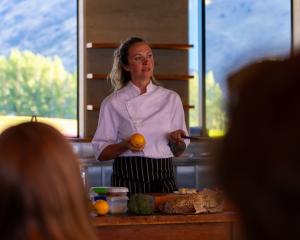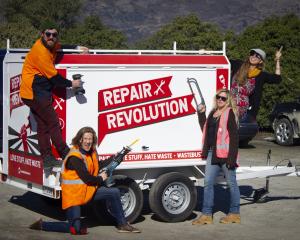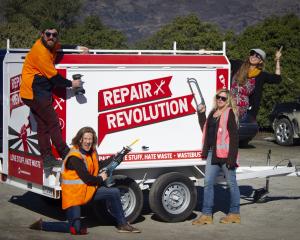
Gina Dempster's always had a turbulent relationship with housework.

It worked, well, kind of. Our house didn't look too bad most of the time, (so long as you didn't look in drawers or cupboards, which were overflowing with random stuff). We had lots of fun as a family, especially outside the house. But being at home wasn't very relaxing. Everywhere I looked, there were jobs to do and things lying around. No matter how much I cleaned up, it would revert back to a mess in a day or two. It drained my energy because life seemed like a never-ending list of jobs.
The Christmas holidays seemed like a good time to sort through all our stuff and to pare it down a bit. I tried to use William Morris' advice from 1880, "Have nothing in your houses that you do not know to be useful or believe to be beautiful", as a yardstick. I let some stuff go, but the trouble with "useful and beautiful" is that potentially everything you own could be useful one day - if you fixed it, if your life changed, if the other one you have was broken. Or it's beautiful - but it doesn't suit you or your home. It was exhausting, like trying to measure things with a mental piece of elastic.
And then someone told me about Marie Kondo. If you haven't come across her yet, she's a tiny Japanese woman whose calling is to teach the world to "tidy up". Since the age of 5, she has been an obsessive cleaner and organiser of stuff, even sneakily throwing out neglected items belonging to the rest of her family.
"If no-one noticed they were missing, I disposed of them, one item at a time, just as if I were thinning plants," she writes in The life-changing magic of tidying, a three million copy best-seller.
Marie's mantra is to keep only objects in your house that "spark joy". It's easy to mock the concept of objects sparking joy and it's a gift to comedians. New Zealand comedian Tom Sainsbury does a great "Joanna Marie Kondoes the house" on Facebook, which includes shedding tears over the joy sparked by her old dish scrubber from the back of the cupboard.
"It may be an ugly little f...er, but its my little f...er. I'm keeping it, I'm keeping it! Oh, I feel so much better for doing the Marie Kondo thing."

Marie Kondo's Netflix show (launched on New Year's Day) demonstrates her simple formula to decluttering. Participants are in for a once-in-a-lifetime marathon cleanout. They declutter by object, not by location, in a set order, staring with clothing. The show starts with them getting every piece of clothing they own on the bed and going through it all at once to see what "sparks joy". All of the participants are shocked to see how much they actually own, which makes it easier to let stuff go.
So I tried it. I got out all my clothes, even the old ones I had stored in boxes. The ones in storage didn't smell fresh or look loved. Why had I kept them all this time? Looking at them all together, I realised that what they had in common was "moments of brilliance"; those peak times in your life when you look like your best self. It hit me that happiness is about more moments of brilliance (well as close as you can get to brilliance once you hit middle-age), not hanging on to past ones.
I washed all the stored clothes and went through every piece of clothing I owned. I made a pile of clothes to take to Wastebusters and a pile for the rubbish bin of clothes too worn for anyone else to want. The ones that are left make me happy. I tried the "Konmarie" method of folding clothes so they can be stored in drawers vertically. It works for me. I can see everything at a glance, which makes deciding what to wear a lot more fun. I have fewer clothes, but I wear more different outfits. And the "floor-drobe" has gone!
Thinking about joy makes decluttering simpler. It brings the choice back to now. Not one day. Not maybe ... Not if ... Just the act of handling all the stuff you own changes your relationship to it.
Of course, its simplistic to suggest tidying up will solve the big dramas of life! And yes, too much stuff is a First World problem, and there are people in our own country who can't afford enough food let alone stuff. But what I like about Marie Kondo's TV show is that it very, very gently questions our relationship with consumerism. All of these families have more stuff than they need, and it's making them less happy. More stuff can make you feel worse! That simple message goes against nearly every piece of advertising we've ever been subjected to.
It's also not about buying more stuff to deal with the stuff that you have. Marie Kondo doesn't tell people what to keep or that the answer to too much stuff is more storage. The only storage solution she brings into their homes is a stack of small cardboard boxes. Instead, it's up to the participants to figure out how they feel about the object. And then they make the decision: keep it or discard it.
There is a lot of discarding in the show. Marie Kondo rejoices in her clients expelling up to 150 bags of stuff in their marathon cleaning efforts. Much of it goes to op shops. Lots of us are living with stuff that we've been given or grown out of which someone else might find joy in. But the rest is too worn, broken or shoddy to be attractive to someone else, so that has to go to landfill.
Some critics suggest that Marie Kondo is implicitly encouraging consumption, because people might be tempted to replace their discards with new stuff. But to be fair to Marie Kondo, she isn't encouraging people to satisfy what she describes as the "craving" for new things. In her book, she talks about former shopaholics who were previously driven to keep buying new things.
"Once they had selected and kept only those things they really loved, they felt that they had everything they needed."
Whatever your thoughts on Marie Kondo, it's undeniable that she has struck a global nerve. Her name is now a verb - to "Marie Kondo" your house. She's an unlikely superstar - a solitary girl who grew up more comfortable with objects than people, and who used to rush home from school for a couple of hours of tidying. Her success demonstrates that "peak stuff" is upon us. Even if you disagree with her solution, she has framed the problem of too much stuff in a way that people can hear and identify with.
Once you've donated and landfilled all those unjoyful things, can you break the pattern of bringing them into your house? I'm only partway through my marathon declutter, so I can't comment on the end result. But so far I'm spending more money to buy fewer things which I really love, and passing up cheaper things which would do the job and nothing more. It's great for the house, if a little punishing on the cashflow. Overall, the house feels a lot more relaxing and the housework is less of a grind, even if on the surface it doesn't look too different to visitors.
Maybe I'm too hopeful, but the popularity of Marie Kondo makes me wonder "What if?". What if people are finally figuring out that consumerism makes companies rich, not people happy. What if people could break their craving for new things. What if we only bought things we really need and love? What if we figured out what the holes in our lives were that we're trying to fill with more stuff? What if we felt like we had enough?
In that world, we might buy less stuff, but spend more on it. We'd fix and repair the things we loved. We'd buy from companies who plan an end-of-life resource recovery solution for the stuff they sell. We wouldn't expect op shops to suck up all the cheap, crappy stuff we want to get rid of, so we can buy more cheap, crappy stuff. We'd teach our kids what it's like to have enough. And we'd spend more time doing things with them instead of shopping and cleaning up the clutter in our homes.
I'm waiting for that world to be a reality. In the meantime, I'm Marie Kondoing my house. I'll let you know how it pans out. To be continued ...
Is the Marie Kondo method for you?
Yes (maybe) if:
- Most of the fights you have with your family are about mess and housework
- You put in a massive effort tidying the house, and the next day it looks just the same
- You want to be in control of your stuff, rather than your stuff being in control of you
- You have to leave home to have a holiday
- You leave unpacked bags sitting on the floor until the next time you go away
- You are prepared to handle every item in your house and see what ‘‘sparks joy’’
No (maybe) if:
- You’re a project manager in your day job
- You’re already happy with how tidy your house is
- You take pride in your cynical outlook on life (definitely don’t read the book!)
- You have a baby and/or toddlers, and are short of sleep
- You or your partner is a hoarder. More serious interventions may well be needed, but in the meantime there’s a Netflix reality show for you too, Consumed.












